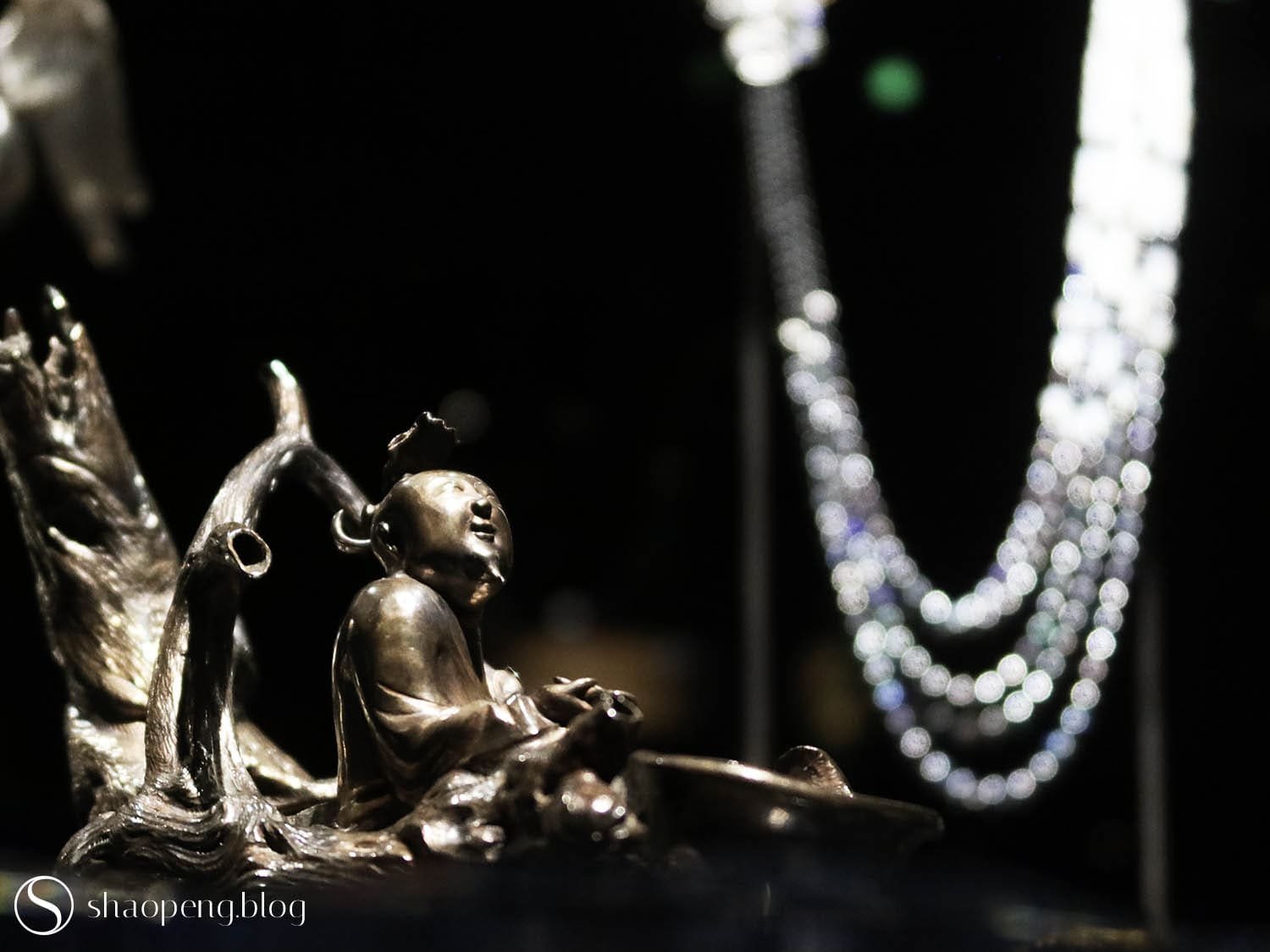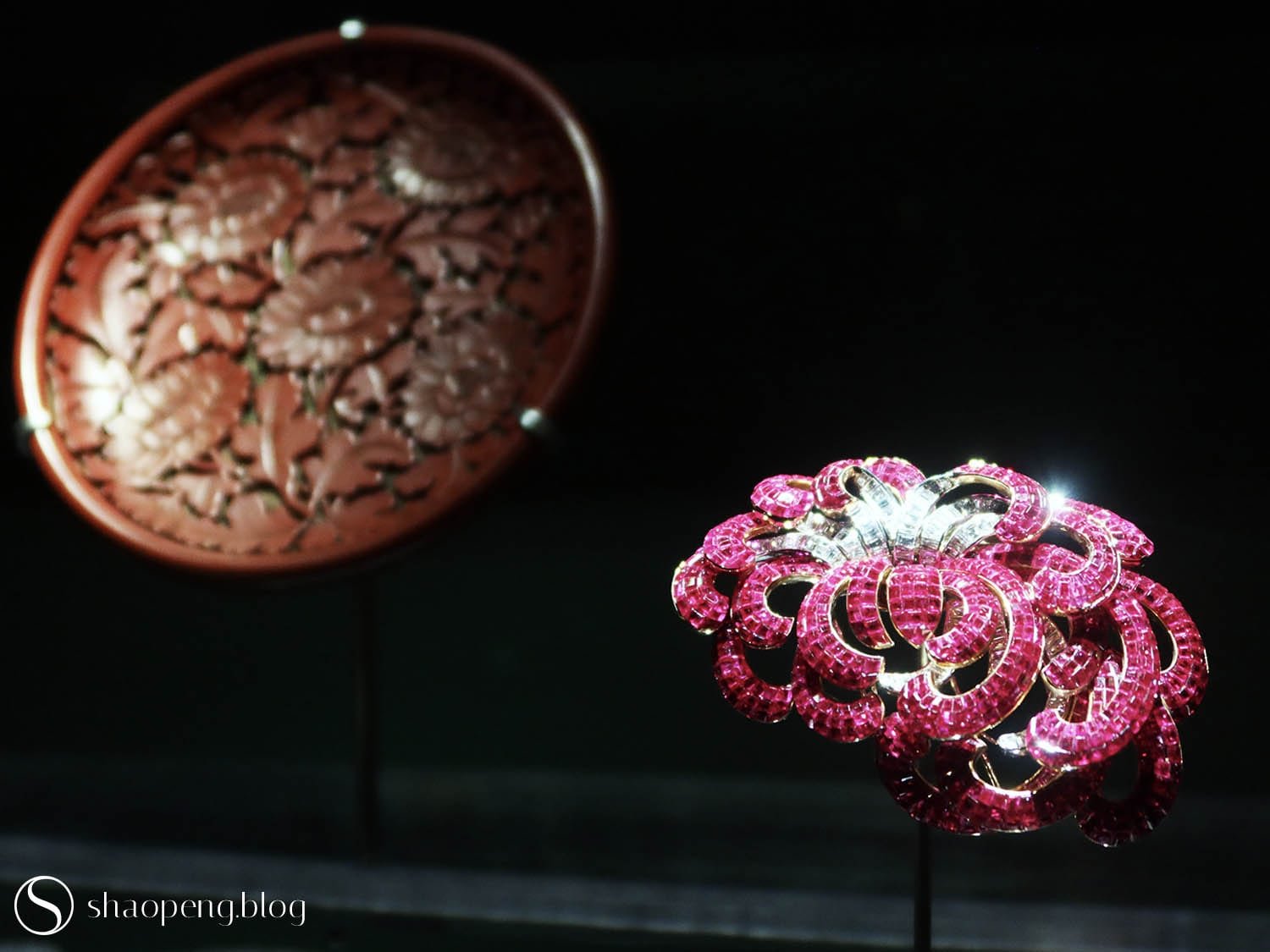Cross-Cultural Dialogues at “Beauty Speaks for Itself” in Taipei
At Taipei’s National Palace Museum, Beauty Speaks for Itself sparks a dynamic dialogue by juxtaposing objects from varied origins, eras, and mediums, inviting visitors to reflect on ideals of beauty across cultures, time, and space.
Sense of Wander: ★★★★☆
Zhang Qian, a renowned Chinese explorer and diplomat of the Western Han dynasty (202 B.C–9 A.D), is depicted riding a raft in a silver sculpture created by Zhu Bishan. He gazes into the distance against the backdrop of a long necklace of beads carved from moonstone, opal, chalcedony, and onyx.
TAIPEI, Taiwan — Beauty Speaks For Itself, a highly anticipated exhibition, opened earlier this fall at the National Palace Museum in Taipei.
The exhibition title was inspired by the Chinese philosopher Zhuangzi (circa 369-286 B.C.), who claimed that “heaven and earth have their great beauties but do not speak of them.”
For those who have experienced it, beauty — as Plato once argued — isn’t found in the material world but, rather, in an ideal that transcends individual experiences. But what is this unspeakable sensation we encounter when we’re in the presence of beauty? And while we know that beauty is subjective, could there possibly be a set of universal ideals that define it?
Beauty Speaks for Itself features works selected from the collection of the National Palace Museum, the Musée des Arts Décoratifs in Paris, and Van Cleef & Arpels, the renowned French maison celebrated for its poetic jewellery creations.
Upon entering the gallery, you are immediately drawn to the first display case showcasing three distinct objects: a revolving openwork vase adorned with dragon and lotus motifs in yangcai enamels from the National Palace Museum, a wine-red buire de Blois (porcelain ewer) from the Musée des Arts Décoratifs with Asian-inspired designs, and a mid-20th-century Zip necklace by Van Cleef & Arpels.
The relationship between these objects isn’t immediately clear to me, and I can’t help but wonder if this is just an introductory display, with each institution presenting their best piece. But as I take a closer look, I begin to see that the two vessels have been chosen for their embodiment of the exhibition’s five themes: nature, movement, fantasy, secret, and colour. The necklace in the centre, an avant-garde piece renowned for its patented mechanism and transformability, doesn’t tick all the boxes. Slightly disappointed, I move on to the next gallery, hoping to uncover deeper connections.
A bracelet featuring red and white roses design (left) accentuates the quintessential Northern Song dynasty ding ware (centre), whose surface is elegantly incised with peony decorations, alongside a Central Asian jade bowl (right) adorned with rubies and emeralds.
The chrysanthemum serves not only as the inspiration for this timeless clip by Van Cleef & Arpels from 1937 but also for a lacquer round dish from the 15th and 16th centuries.
One can’t help but notice the striking similarity — and the poetry — between this flower brooch and the Jardinière glass vase by François-Eugène Rousseau.
Nowhere is beauty more present than in the embrace of mother earth. Humans have always sought inspiration from the natural world, where birds and flowers have been imbued with symbolic meanings. As an inexhaustible source of inspiration, it’s only fitting that nature is chosen as the first theme to be presented in the exhibition.
It’s refreshing to see a luxurious bracelet adorned with ruby roses and emerald foliage displayed alongside a pristine white-glazed ding ware, its surface faintly incised with peony designs, and a jade bowl set with precious stones. A chrysanthemum brooch, emblematic of Van Cleef & Arpels’ Mystery Set, is elegantly paired with a Ming-dynasty (1368-1644) lacquer dish intricately carved with floral patterns, and Katagami paper stencils showcasing chrysanthemum blossom.
In another case, a sea horse carved out of coral engages in dialogue with a giant ruyi scepter embellished with a kaleidoscope of carved gemstones.
While the creatures of the deep ocean, dense forests, and high skies conjure extraordinary imagination, it is in the realm of fantasy that mythical beings inspire artists to create works of art in myriad shapes, forms, and colours.
In particular, the dragon and phoenix — a divine pairing intertwined with Chinese civilisation for millennia — find their way into ancient China’s imperial wardrobe, decorative arts, and even objets d’art in the West, fulfilling Western fantasies of the mystical Far East.
On display, a copper ewer captures my attention — its luminous enamel painting depicts an elegant phoenix gracefully poised among auspicious cloud. Hovering above it is a brooch — a bird carefully holding a 96.62-carat briolette-cut yellow diamond in its beak. This Bird clip and Walska pendant — named after its former owner, American opera singer Ganna Walska (1887-1984) — has been a hallmark of Van Cleef & Arpels’ creative legacy since the 1920s. After admiring this piece in prints and images countless times, I’m finally seeing it in person.
Semi-precious stones play a significant role in decorative arts. Here, coral depicts a fantastical sea creature, while a plethora of coloured gemstones adorn a ruyi scepter from the Qing dynasty (1644-1911) placed in the back.
Simone Pheulpin’s powerful textile sculpture, Jeromine, takes the spotlight away from a 13th-century ding ware (centre) and from a diamond necklace and brooch (right) by Van Cleef & Arpels.
A pair of Van Cleef & Arpels fairies, symbols of joy and hope, graces the exhibition alongside a bronze sculpture of the dancer Marie Taglioni.
One of my favourite display is nestled in the gallery dedicated to the theme of Movement, which explores both the physical manifestation of motion in art and the dynamic exchanges that enrich artistic expression. This theme comes to life in the gallery’s first display case, featuring a hefty Chinese bronze vessel from the Warring States period (475-221 B.C.), alongside a set of bracelets and necklaces designed in classic style, and a pair of calcedony vases adorned with elegantly twisted rope handles.
As I stand before this showcase, I feel as though my feet are glued to the ground. Though I’m familiar with these objects, I’ve never expected the profound dialogues that could emerge from them, especially since we’re so accustomed to seeing things in their original context. The way these exhibits — drawn from different eras, materials, and aesthetic ideals — come together has left an impression on me.
A bronze vessel from the Warring States period (475-221 B.C.) lends historical weight to the classical-inspired jewellery and opaline vases.
Luna long necklace from Van Cleef & Arpels’ Les Voyages Extraordinaires collection is elegantly poised among decorative arts of various styles, materials, and aesthetics ideals.
Another showcase, featuring the butterfly motif, also takes me by surprise. Besides the hanging scroll and ceramic vessels, I discover a set of butterfly clips from the Van Cleef & Arpels Collection, created in collaboration with Hakose San, a Japanese master lacquer artist. I also spot the iconic Butterfly Stool by Japanese designer Sori Yanagi, where the seat extends outward like the flutter of butterfly wings. Above it, a golden fan painted with flowers and butterflies by the celebrated Ma Shouzen (circa 1548–1604), a Chinese courtesan and artist, completes this the delightful arrangement.
In the gallery dedicated to the theme of Secret, selected works from the National Palace Museum, the Musée des Arts Décoratifs, and Van Cleef & Arpels come together to create a mesmerising cabinet of curiosity.
The exhibition culminates in a stunning showcase of the Jadeite Cabbage — Taiwan’s National Treasure — positioned upright, a rare sight indeed. Framing it is an Indian-style necklace by Van Cleef & Arpels, set with melon-cut emeralds. To its right is an objet d’art from the Musée des Arts Décoratifs collection, featuring a ruyi and a vase delicately carved from rock crystal, dating back to the Qing dynasty (1644–1911). This final arrangement, embodying the aesthetics of the Far East, becomes the centrepiece for curious visitors who are eager to catch this rare sight.
This glass case celebrates the enchanting world of butterflies, highlighting their traces in furniture design, fan painting, hanging scroll, decorative arts, ceramic wares, and jewellery.
The millefiori — meaning “a thousand flowers” — design sweeps across bowl, vases, and jewellery.
“… the richness of the collections, when combined, invites visitors to reflect on their own definitions and ideals of beauty.”
With over 260 works of art, Beauty Speaks for Itself showcases an impressive array of objects, including ceramics, glass, bronze, jade, silver, gold, textiles, and wood. The involvement of the French Maison, in particular, treats visitors to an impressive selection of jewellery pieces from its archive. As a jewellery designer, I sometimes find myself viewing the decorative arts on display as mere supporting elements for the jewellery.
Japanese architect Tsuyoshi Tane, who designed the exhibition space, draws inspiration from shadow puppetry, creating a mesmerising atmosphere that leaves visitors lingering between dream and reality.
Despite the immersive nature of the visiting experience, I would argue that the exhibition’s lighting could be improved. Unlike a jewellery exhibition where specialised lighting is used to highlight the lustre and colour of gemstones, this exhibition adopts a rather dim ambiance. Though this decision is likely intended to protect some of the artefacts from long-term exposure to light, it also diminishes the beauty of the jewellery, relegating it to the status of decorative arts.
What fascinates me most about the exhibition is how the objects on display truly exemplify the notion that beauty speaks for itself. The dialogues that emerge from the arrangement, too, is refreshing. On top of that, the richness of the collections, when combined, invites visitors to reflect on their own definitions and ideals of beauty.
When asked to define beauty, Béatrice Quette, curator of the Musée des Arts Décoratifs, responds, “When something is able to evoke my emotions, it is beautiful.”
While visitors to this exhibition come from diverse social and cultural backgrounds, it’s evident that they all share a deep appreciation for the works of art before them. Some pieces impress, while others amaze and surprise. Perhaps, after all, beauty is universal. While beauty may speak for itself, I’d add that it sometimes whispers through its details.
Beauty Speaks for Itself culminates in a striking juxtaposition of Taiwan’s National Treasure, the Jadeite Cabbage, alongside a sumptuous emerald necklace crafted by Van Cleef & Arpels.
Reference:
Chen, F. & Chuang, A. (2024, October 18). 美自天成:VAN CLEEF & ARPELS梵克雅寶與故宮的相遇 [Beauty speaks for itself: The encounter of Van Cleef & Arpels with the National Palace Museum]. ELLE Taiwan. https://www.elle.com/tw/fashion/issue/g62438474/beauty-speaks-for-itself/
Beauty Speaks for Itself — Selected works from the National Palace Museum, Paris’ Musée des Arts Décoratifs and Van Cleef & Arpels is on view at the National Palace Museum in Taipei until December 29, 2024. The exhibition will relocate to the Southern Branch of the National Palace Museum in Chiayi county from January 23 to April 20, 2025.












